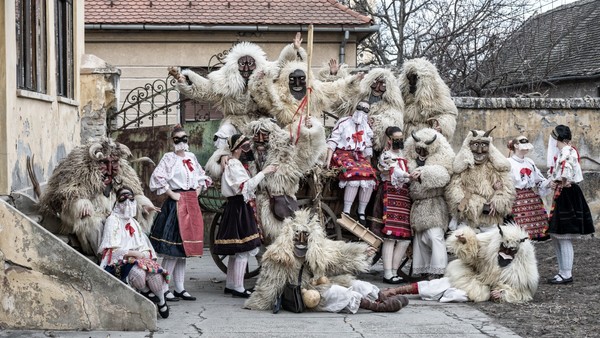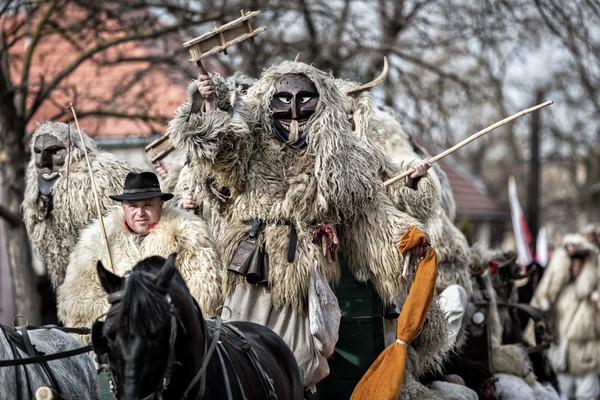Farsang – the annual carnival season in Hungary

[아츠앤컬쳐] 크리스마스 이후에는 헝가리에서 가장 흥미로운 시즌 중 하나가 시작되며, 부활절 전 40일간의 사순절 기간의 첫날인 재의 수요일까지 이어진다. 크리스마스 시즌이 끝나는 1월 6일부터는 ‘퍼르션그’라는 거대하고 다채로운 축제 기간이 시작된다. 이 기간은 온갖 음식과 가장무도회, 고등학교 졸업 파티 등으로 가득하다. 가장 유명한 행사 중 하나는 헝가리 남부 도시 모하츠의 유네스코가 인정한 축제이며 기독교 전통에 여러 고대 의식이 결합된 축제로, 겨울에 상징적 작별을 하고 따뜻한 봄날을 기다리는 ‘부쇼야라시’가 있다.
이 시기는 고대인들에게는 다산의 시기로, 이를 위해 의상을 차려 입고 삶의 기쁨을 표현하며 춤과 환희가 가득한 축제를 즐겼다. 수세기 전 무도회는 주로 귀족들이 주최했지만 마을에서 길드나 노동자 무도회도 있었다. 이러한 파티는 소년들이 주최했다. 노점의 소녀들은 소년들에게 꽃을 주었고 그들은 무도회가 끝날 때 공개적으로 모자에 꽃을 꽂았다. 부활절 전 40일간의 사순절은 결혼 금지 기간이어서 이 무도회 시즌은 약혼과 결혼식을 위한 시기이기도 했다. 국가적으로 유명한 무도회는 150~200년 전에 페스트와 부다에서 열렸는데, 최초의 오페라 무도회는 1886년 부다페스트에서 열렸다.

‘부쇼야라시’는 가장 눈길을 끄는 연례 행사 중 하나다. 수백 년 전통의 이 카니발은 6일간 진행되며 퍼르션그가 끝날 무렵에 개최된다. 행사 기간 동안 방문객들은 창작 활동, 가장무도회, 민속춤, 음악, 캠프파이어 등 다양한 프로그램을 즐길 수 있으며, 헝가리 전통 요리를 맛보고 퍼르션그의 대표적인 음식인 갓 만든 미니 도넛을 맛볼 수 있다.
부쇼는 전통적으로 무서운 의상을 입고 독특한 나무 가면과 양가죽으로 만든 털 망토를 두른 남성이다. 부쇼는 추위를 쫓아내는 동시에 봄의 도래와 다산, 부활을 축하한다. 그들은 군중 사이를 다니며 겨울을 쫓는 상징으로 장난을 치고 많은 소음을 내며 돌아다닌다. 16세기부터 전해 내려오는 전설에 따르면, 당시 오스만 군대의 침략을 피해 모하치에서 인근 습지와 숲으로 피신한 쇽치족(크로아티아의 남슬라브 민족)이 있었다. 어느 날 밤 한 노인이 무서운 가면을 쓰고 물건을 딸깍딸깍 울려서 오스만 군대를 쫓아내자는 아이디어를 냈다. 밤이 되자 쇽치족은 배를 타고 다뉴브강을 건너 오스만 군대를 쫓아냈다. 이 이야기는 실제 역사적 근거가 없음에도 불구하고 여전히 마을 사람들에게 인기가 많다.

매년 카니발 시즌이 끝날 때, 부쇼는 집집마다 방문해 좋은 소원을 빌고 마술을 선보이며 음식과 음료를 선물로 받곤 했다. 오늘날 이 인기 있는 관습은 그 기원을 대부분 잃어버렸지만 다른 많은 매력을 얻게 되었는데, 대형 페리를 타고 다뉴브 강을 건너거나 강에서 묵은 겨울의 관을 가라 앉히는 등의 이벤트를 펼치며 진정한 겨울의 축제를 마친다.
카니발의 주요 행사 중 하나는 축제의 두 번째 밤에 열린다. 밀짚인형을 모하치의 중심으로 운반하여 모닥불에 태우는 동안 마을 사람들은 손을 잡고 불 주위에서 춤을 춘다. 축제 기간 동안 약 800명의 부쇼와 다른 종류의 의상을 입은 200명의 관람객이 모하치 축제에 참여한다.


Farsang – the annual carnival season in Hungary
After Christmas, one of the most interesting seasons in Hungary begins, lasting until Ash Wednesday, the first day of the 40-day Lent that precedes Easter. From the 6th of January, which marks the end of the Christmas season, a huge, colorful festival period called „Farsang” begins. This "carnival" season is filled with eating decadent food, masquerades, and also high school proms for the graduates. One of the most famous events is the UNESCO-recognized festival called "Busójárás" in the southern Hungarian city of Mohács. Busójárás is a combination of Christian traditions and several other ancient rituals, as well as a symbolic farewell to winter, looking forward to the warmer days of spring.
For ancient peoples, the end of winter and the beginning of spring also marked the fertility period, which was celebrated by dressing up in costumes. These gatherings were characterised by merriment, the expression of joy of life, dancing and revelry.
Centuries ago the balls were mainly organised by members of the aristocracy, but there were also guild or workers’ balls. In the villages, these parties were organised by the boys. The girls in the stalls would give flowers to the chosen lads, who would pin them on their hats in public at the end of the carnival. The ball season was therefore also a time for engagements and weddings, as marriages were forbidden during 40 days-long Lent before Easter. The tradition of the modern-day lawyer's, doctor's balls dates back to the period between the two world wars, although balls of national fame were held in Pest and Buda as long ago as 150-200 years. The first Opera Ball was held in Budapest in 1886.

One of the most eye-catching annual ritual is the „Busójárás”. This carnival dates back hundreds of years and celebrates the end of winter and the beginning of spring. The Busójárás ritual lasts 6 days and is organized at the end of the carnival season. During the carnival, the participants symbolically bid farewell to winter. Busós chase away the cold, while at the same time they celebrate the coming of spring, fertility and rebirth. During the event, visitors can choose from several programs such as creative activities, masquerade, folk dance, music and bonfires, while they can also explore the traditional Hungarian cuisine and try the typical Farsang food, the freshly made mini-doughnuts.
Busós are traditionally men wearing scary costumes, unique wooden masks and woolly cloaks made of sheepskin. They chase and circulate among the crowd, playing practical jokes and making a lot of noise as a symbol of chasing away winter.
According to legends originating from the 16th century, the local Šokci people (a South Slavic ethnic group from Croatia) fled from Mohács to the nearby marshes and forests to escape the Ottoman troops that were invading a large part of Hungary at that time. One night an old man appeared and came up with the idea of making frightening masks and rattling and clattering objects to scare away the Ottomans. At night, the Šokci crossed the Danube with their boats and chased away the Ottomans. Despite the fact that the story has no real historical basis, the legend of Busós is still very popular among the townspeople.
Every year, at the end of the carnival season, the Busós would go from house to house to express their good wishes, perform magic tricks and receive gifts of food and drink. Today, this popular custom has lost most of its origin, but has gained numerous other attractions. It is a real end-of-winter festival with such events as the crossing of the Danube in large ferries or the sinking of the coffin of Old Winter in the river.
One of the main events of the carnival takes place on the penultimate night of the festival, when a straw man is carried into the center of Mohács and burned in a bonfire, while the townspeople hold hands and dance around the fire. The festival usually attracts about 800 busós and 200 revelers in other types of costumes during the event.

글 | 언드라시 스츠 András Szűts
주한리스트헝가리문화원 부원장
Liszt Institute - Hungarian Cultural Center Seoul


